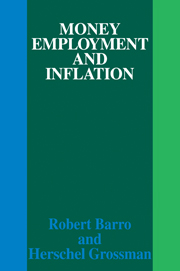Book contents
- Frontmatter
- Contents
- Dedication
- Preface
- Introduction
- 1 The basic model
- 2 Output and employment under non-market-clearing conditions
- 3 Capital, financial assets, and the rate of return
- 4 Inflation and rates of return
- 5 Inflation and unemployment
- 6 The dynamics of aggregate demand
- 7 Output and employment with wage and price speculation
- References
- Index of names
1 - The basic model
Published online by Cambridge University Press: 07 October 2011
- Frontmatter
- Contents
- Dedication
- Preface
- Introduction
- 1 The basic model
- 2 Output and employment under non-market-clearing conditions
- 3 Capital, financial assets, and the rate of return
- 4 Inflation and rates of return
- 5 Inflation and unemployment
- 6 The dynamics of aggregate demand
- 7 Output and employment with wage and price speculation
- References
- Index of names
Summary
This chapter develops a simple model which serves as our basic analytical framework. Section 1.1 outlines the essentials of this model. Section 1.2 analyzes the behavior of individual economic units within the basic model. Section 1.3 develops comparative-statics analysis. Section 1.4 analyzes wage and price dynamics.
The essentials of the basic model
The basic model involves four economic goods – labor services, consumable commodities, public services, and fiat money – and three forms of economic decision-making unit – a fixed number of firms, a fixed number of households, and government. Labor services and public services are the only variable inputs into the production process. Other inputs have a fixed quantity, no alternative use, and zero user cost. Current output consists of consumable commodities and public services. All current output is produced by the same technology, and only assumes its specific identity according to the identity of its purchaser. In particular, household purchases are consumables and government purchases are public services. Fiat money is the only store of value; it also serves as a medium of exchange and unit of account. Transactions involving money are costless, and receipts and disbursements of money are perfectly synchronized.
Firms demand labor and supply both consumable commodities and public services. They attempt to maximize profits. These profits represent a return to the nonvariable inputs, of which each firm possesses a predetermined and fixed amount. Profits are essentially economic rents earned by the nonvariable inputs.
- Type
- Chapter
- Information
- Money Employment and Inflation , pp. 7 - 37Publisher: Cambridge University PressPrint publication year: 1976



